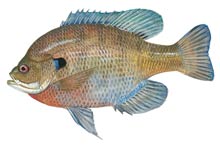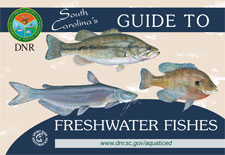Freshwater Fish - Species
Species Specific Regulations
Bluegill
Freshwater Fishing License required.
Bluegill (Lepomis macrochirus) - Native
Description: (Anatomy of a Fish)
The bluegill is a laterally compressed or flattened sunfish, olive in color with an orange to yellow breast with clear fins except for a distinguishing large black smudge near the bottom of the soft dorsal fin. The operculum or gill cover is tipped distinctly with black and there are several wide dark vertical bars on the side of the body. Bluegills have small mouths with no teeth on the tongue. The bluegill name comes from breeding males who exhibit pale blue to violet on the top half of the body with powder blue on the lower jaw and lower portion of the operculum or gill cover. The breeding males also develop a red breast.
Range: Statewide including all rivers as well as small and large impoundments
Average Length: 5-10 inches
Average Size: 3-8 ounces
South Carolina State Record: 3-pounds, 4-ounces (1973)
Life Expectancy: Approximately 11 years
Preferred Habitat
Bluegills are very tolerant of many habitat types including pools of creeks and rivers, swamps, oxbow lakes, ponds, vegetated shores of impoundments, man-made lakes, ponds and retention basins. They prefer sluggish or slow-moving water.
Food Habits
- Bluegills are opportunistic carnivores feeding on a variety of prey types. They will feed on mature and immature insects, small invertebrates, crayfish, mollusks (mussels) and other fishes.
- They have small mouths; however, the larger the bluegill the larger the prey type they can consume. They mostly feed near the surface.
Spawning
- Bluegills are colonial nesters with 100 or more different bluegill nests in one area. This helps provide extra protection for the eggs and fry from predators.
- Bluegill become sexually mature at 1or 2 years of age and then construct nests in shallow water over sand or mud bottoms as water temperatures exceed 75°F, usually from May to August.
- Females can produce up to 80,000 eggs per year. A female may deposit eggs in several adjacent nests within a nesting colony.
- Highly unusual for sunfishes, male bluegill will sneak into nests of other males to deposit their sperm to produce more of their offspring versus another male.
- Males will guard their nests and aerate the eggs by fanning their fins until the eggs hatch, within 1-2 days. Males continue to guard the area as the young fry disperse.
Miscellaneous
Just like largemouth bass, bluegills are one of the most common fishes stocked for angling and food. It has been stocked extensively by state and federal agencies into farm ponds, usually in combination with redear sunfish and largemouth bass. With proper farm management, bluegill can provide many years of successful fishing. Lack of proper management may result in crowded ponds with stunted bluegill, only growing 4 to 5 inches in length. Successful and multiple reproduction of bluegill is important to provide an adequate food source for developing young largemouth bass. Concentrations of large numbers of nesting or bedding bluegill produce an odor which is detectable by experienced anglers.
Commonly Mistaken Species
Some species of fish that are commonly mistaken for this species:
Literature Cited
Rohde, Fred C, Arndt, Rudolf G., Foltz, Jeffery W., Quattro, Joseph M. 2009. Freshwater Fishes of South Carolina. University of South Carolina Press, Columbia, South Carolina.
Wildlife and Freshwater Fisheries Division. 2009. South Carolina Guide to Freshwater Fishes.
Fish Illustration by Duane Raver.


